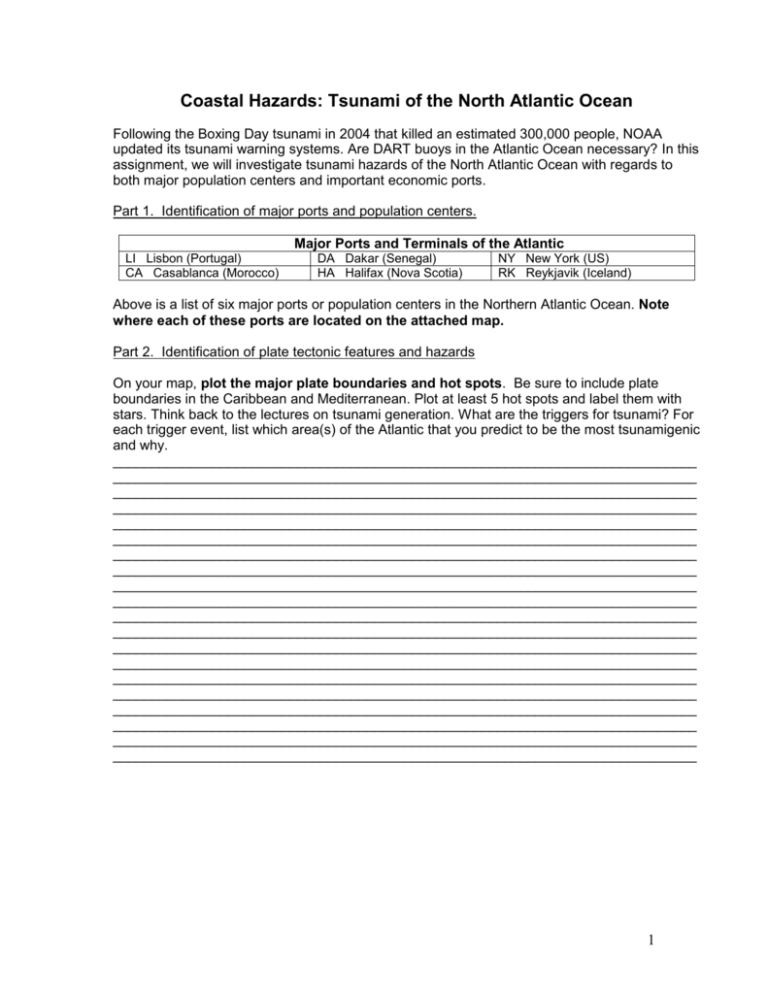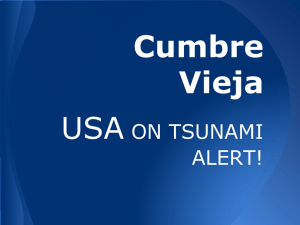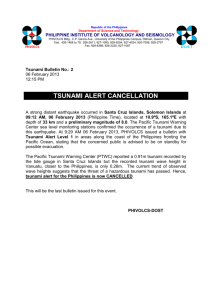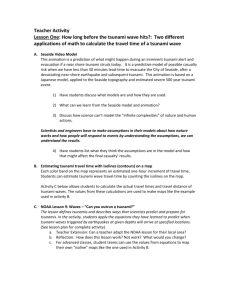Tsunami of the North Atlantic Ocean
advertisement

Coastal Hazards: Tsunami of the North Atlantic Ocean Following the Boxing Day tsunami in 2004 that killed an estimated 300,000 people, NOAA updated its tsunami warning systems. Are DART buoys in the Atlantic Ocean necessary? In this assignment, we will investigate tsunami hazards of the North Atlantic Ocean with regards to both major population centers and important economic ports. Part 1. Identification of major ports and population centers. Major Ports and Terminals of the Atlantic LI Lisbon (Portugal) CA Casablanca (Morocco) DA Dakar (Senegal) HA Halifax (Nova Scotia) NY New York (US) RK Reykjavik (Iceland) Above is a list of six major ports or population centers in the Northern Atlantic Ocean. Note where each of these ports are located on the attached map. Part 2. Identification of plate tectonic features and hazards On your map, plot the major plate boundaries and hot spots. Be sure to include plate boundaries in the Caribbean and Mediterranean. Plot at least 5 hot spots and label them with stars. Think back to the lectures on tsunami generation. What are the triggers for tsunami? For each trigger event, list which area(s) of the Atlantic that you predict to be the most tsunamigenic and why. ____________________________________________________________________________ ____________________________________________________________________________ ____________________________________________________________________________ ____________________________________________________________________________ ____________________________________________________________________________ ____________________________________________________________________________ ____________________________________________________________________________ ____________________________________________________________________________ ____________________________________________________________________________ ____________________________________________________________________________ ____________________________________________________________________________ ____________________________________________________________________________ ____________________________________________________________________________ ____________________________________________________________________________ ____________________________________________________________________________ ____________________________________________________________________________ ____________________________________________________________________________ ____________________________________________________________________________ ____________________________________________________________________________ ____________________________________________________________________________ 1 Part 3. Calculate travel times for each location. For the purposes of this assignment, we will concentrate on three distinct sources: CI Canary Islands (volcanic collapse of the west coast of La Palma) (28.7 N, 17.9 W) AN Antilles Trench (megathrust earthquake) (17.9 N, 61.0 W) MA Maritimes Continental Shelf (catastrophic landslide) (44.5 N, 57.0 W) Of concern is the time it would take for a tsunami to reach each of the important ports. We will assume straight lines to calculate distance. We will also simplify by a) assuming constant travel velocity, 2) ignoring effects of seafloor bathymetry or wave refraction, and 3) assuming tsunami waves radiate out equally in all directions. Using a constant open-ocean tsunami velocity of 700 kilometers / hour and the equation: Time = Distance / velocity, calculate the time in hours for tsunami waves to reach each port. Tsunami Travel Times Loc. km CA DA HA LI NY RK 1,120 1,530 4,350 1,370 5,250 3,970 Canary Islands hours km Antillies Trench hours 5,550 4,640 2,970 5,530 2,840 5,920 km Maritimes Shelf hours 4,130 4,970 510 4,030 1,430 3,100 2 Questions: 1. Which city is averages the closest to all three danger zones _______________ 2. Which city averages the farthest distance? ________________ 3. What is the minimum time recorded on your chart? _____ For which city and which tsunami center?___________________ 4. In your opinion, are DART buoys needed in the Atlantic Ocean? Why or why not? ____________________________________________________________________________ ____________________________________________________________________________ ____________________________________________________________________________ ____________________________________________________________________________ 3








